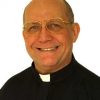Maryknoll priest reflects on Muslim
reverence for the Virgin Mary
In the city of Zamboanga on the island of Mindanao in the Philippines, a Muslim high school student explained to his Jesuit teacher why he had missed class. “Yesterday was the fiesta of the Virgin Mary, Nuestra Señora del Pilar,” the student said. “I visited her shrine at Fort Pilar to pray and ask for her help.”
For Christians and many Muslims of Zamboanga, the Virgin Mary symbolizes the city’s culture, history and destiny. A legend says the city will be destroyed if its people ever stop praying to Our Lady of Pilar, a devotion in Zamboanga dating back to the early 1700s. Many Muslims from the area are known to implore Mary’s protection—particularly in difficult times or before they begin their pilgrimage to Mecca.
The Virgin of Pilar is the main shrine to Mary in Mindanao. It is one of the few Marian shrines not located inside a church, but rather is on the wall of an old Spanish-built fort. The shrine’s outdoor location makes it accessible to Muslims and Christians alike.
In Zamboanga, the Feast of Pilar on Oct. 12 is a day when a remarkable spirit of unity and community is manifested. Some Muslims join the celebration and even light candles as an offering at the shrine. Although there are clear historical and dogmatic divergences between Muslims and Christians, a perceptive Zamboangueño commented: “What is significant about this particular event is … a positive level of relationship is being born, shared and lived … the friendship generated by the Feast of the Virgin of Pilar remains an undiscovered miracle.”
Most Christians are unaware of the Muslim reverence for the Virgin Mary. In 24 of the 34 references to Mary (Maryam) in the Qur’an, she is identified as the mother of Jesus. No other woman is even mentioned by name in the Qur’an. One chapter of the Qur’an (Sura 19) is entitled “Maryam” and narrates events of the Annunciation and Jesus’ birth. In addition, Muslims call Mary Sitti Maryam, with Sitti being a term of endearment because of her privilege to be the mother of Jesus.
Muhammad’s attitude toward Mary was always reverent and respectful. He spoke of her as a sign for all creation and a model for all believers. As the Qur’an notes (66:12), “she put her trust in the words of her Lord and believed in his Scriptures.” The Prophet of Mecca saw Mary as a sign and model because she truly submitted (Islam) to the will of Allah/God. This same virtue of Mary is recorded by Saint Luke: “Mary said: I am the servant of the Lord. Let it be done to me as you say” (1:38).
Another parallel is Mary’s special dignity as one favored by God. The Qur’an (3:42) says: “Allah has chosen you, and made you pure, and exalted you above all women”; the Gospel of Luke (1:28, 42) states: “Hail, full of grace … blessed are you among women.”
The Second Vatican Council advised Catholics on the proper attitude toward their Muslim neighbors. “Although in the course of the centuries many quarrels and hostilities have arisen between Christians and Muslims, this most sacred Synod urges all to forget the past and to strive sincerely for mutual understanding,” the council said in its document Nostra Aetate on Catholic relations with other religions. “On behalf of all humanity, let them make common cause of safeguarding and fostering social justice, moral values, peace and freedom.”
Christians and Muslims are not in agreement in many aspects of faith and doctrine, yet, this does not prevent them from nurturing a deep and mutual reverence for Mary as “Our Lady” (Sayidat). Perhaps Mary can be a bridge to closer fellowship, where Muslims and Christians clasp each other’s hand in worship of the one, true God.
Featured Image: he Andronicus Icon of the Mother of God, Consoler of Women by William Hart McNichols (Courtesy of frbillmcnichols-sacredimages.com)

